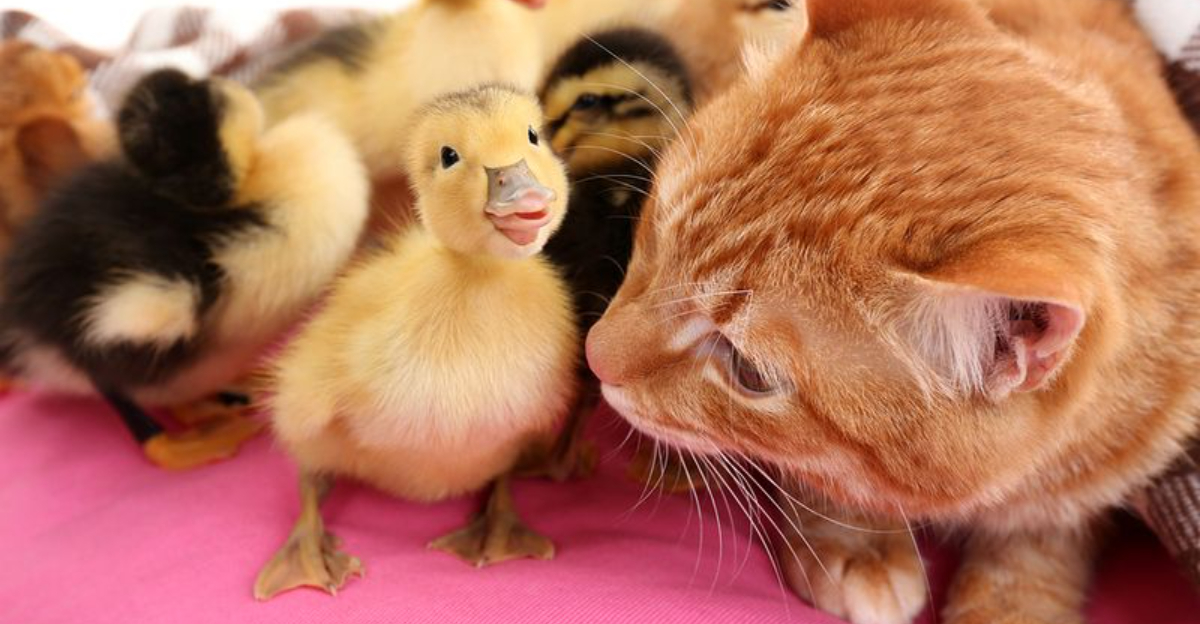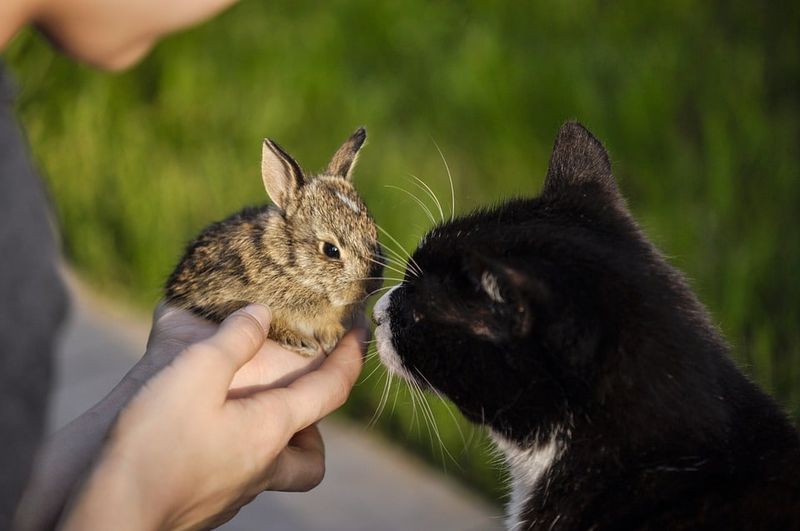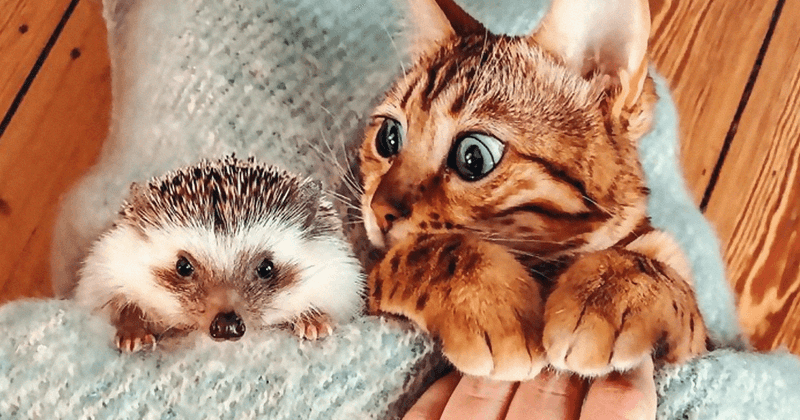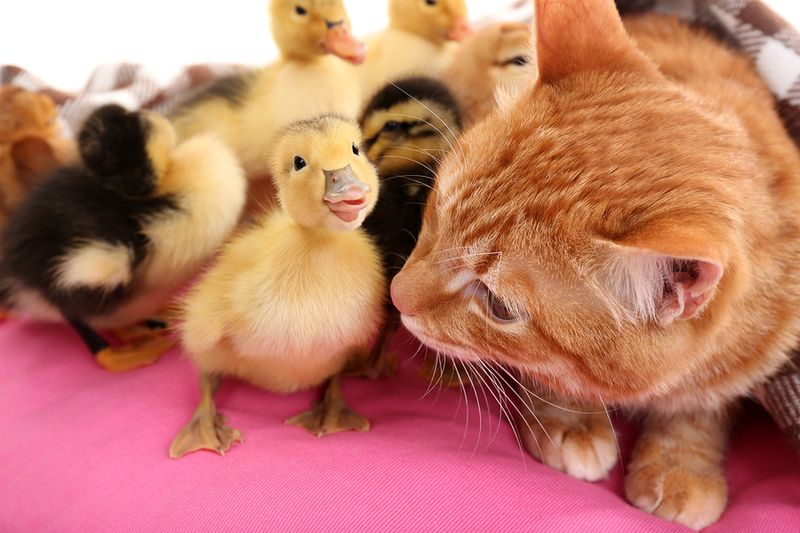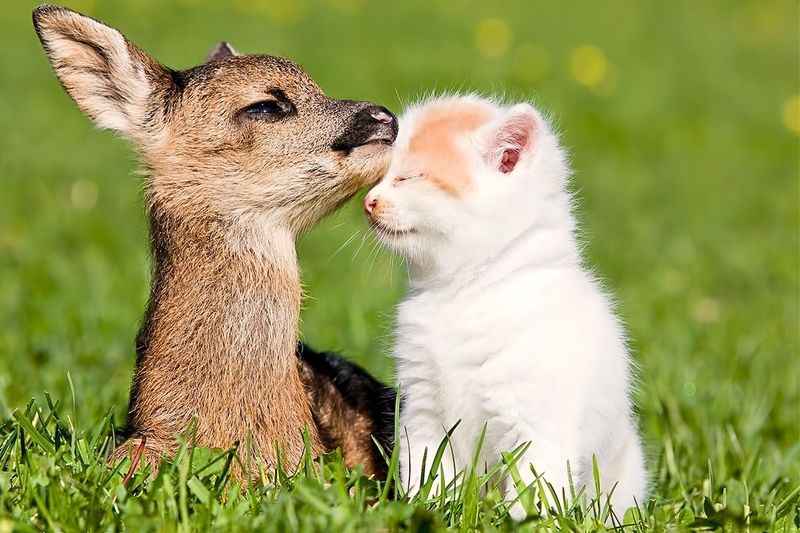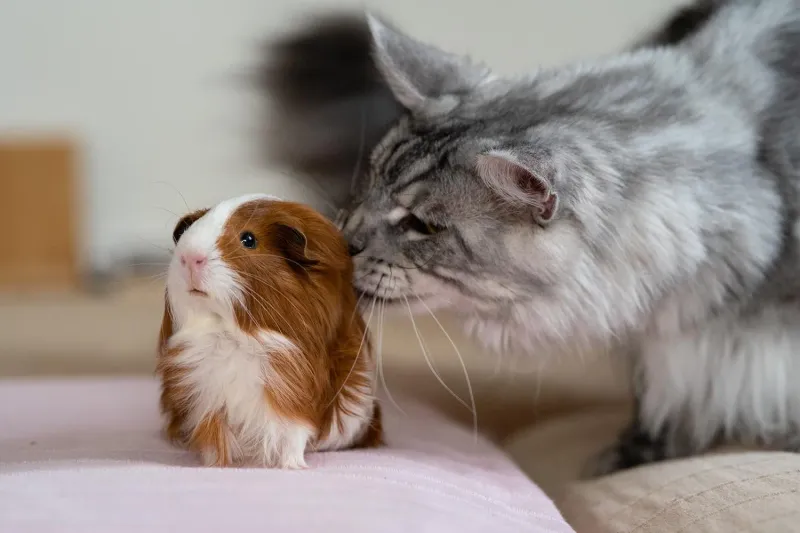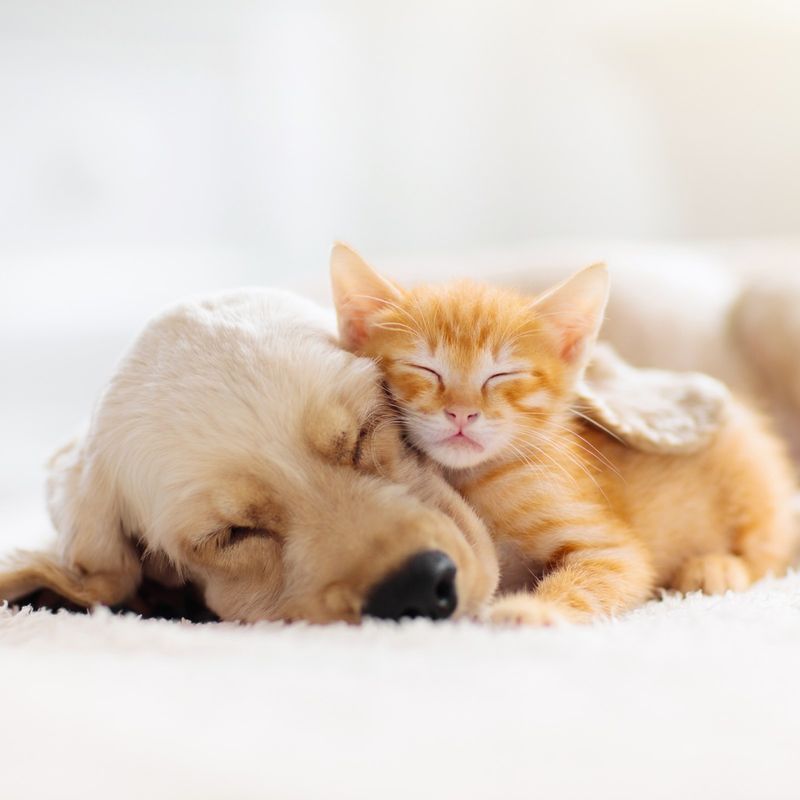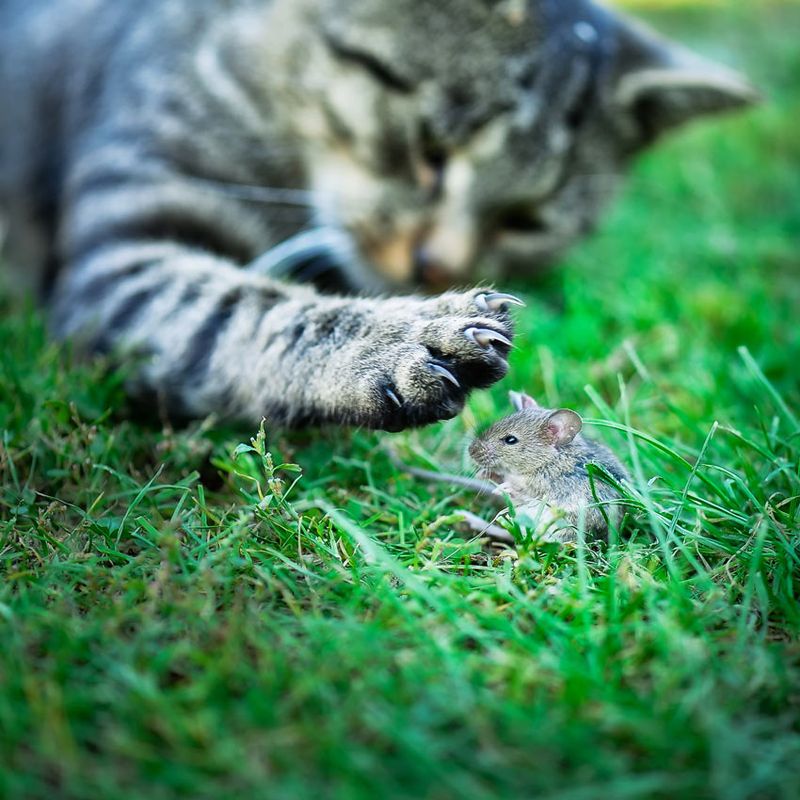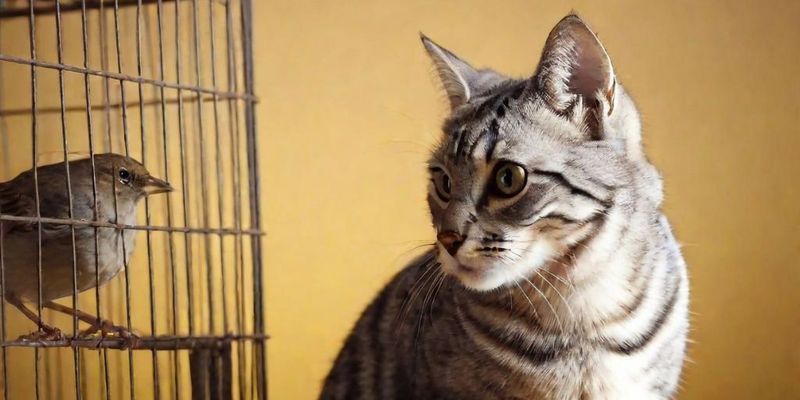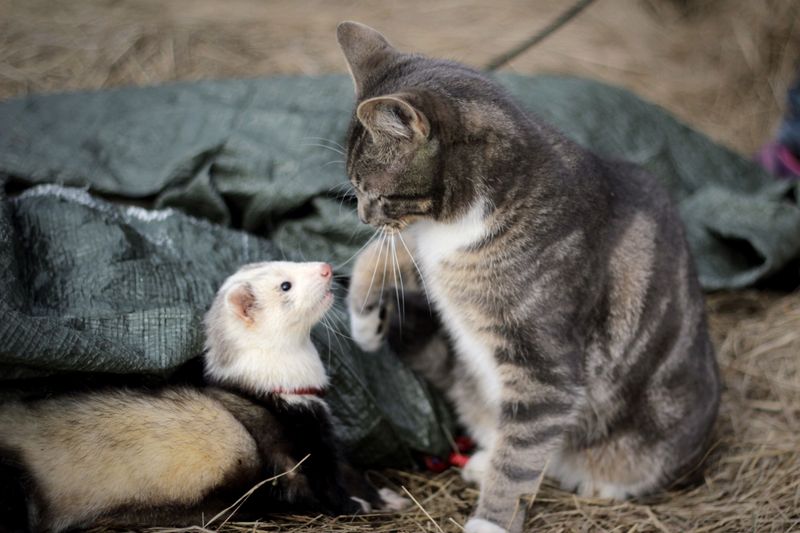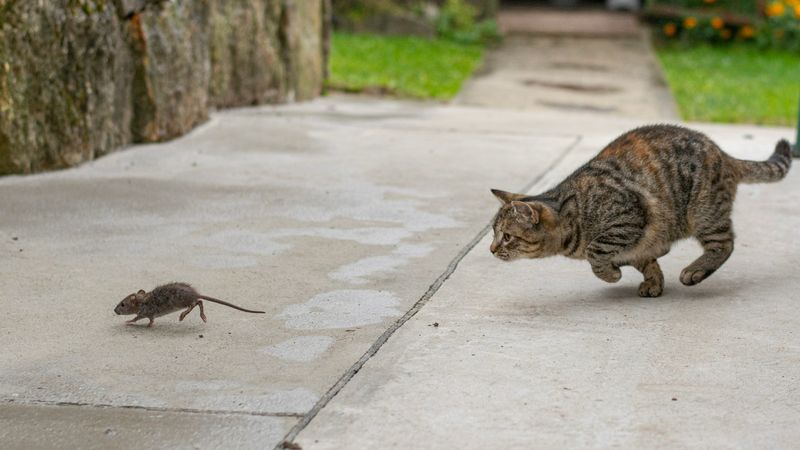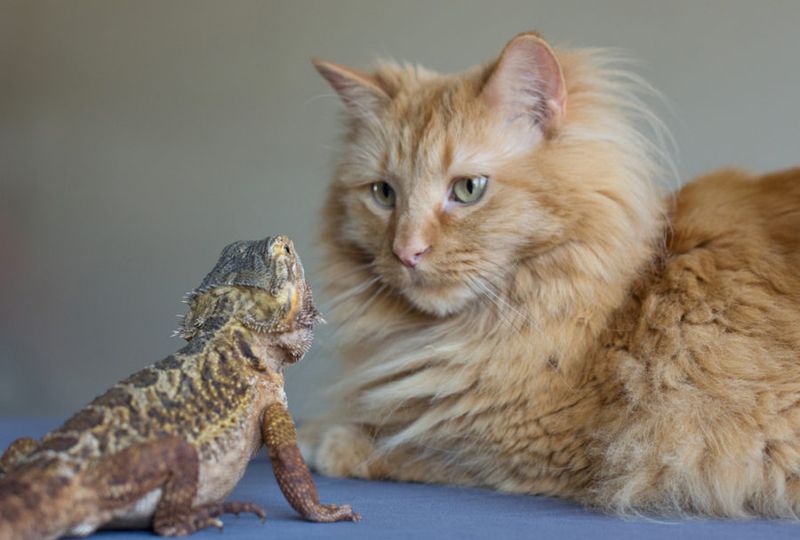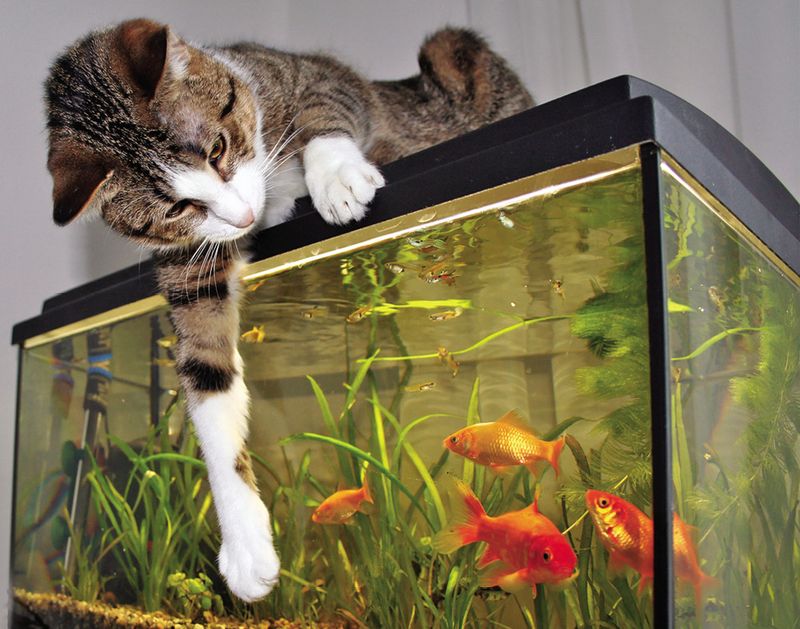📖 Table of Content:
- 1. Rabbits Hop Into Cats’ Hearts
- 2. Hedgehogs Become Prickly Pals
- 3. Ducklings Find Feline Foster Parents
- 4. Fawns Benefit From Feline Fostering
- 5. Gentle Guinea Pigs Join The Family
- 6. Gentle Dogs Create Canine-Feline Families
- 1. Hamsters Trigger Hunting Instincts
- 2. Birds Create Constant Tension
- 3. Ferrets Face Feline Rejection
- 4. Rats Remain Permanent Enemies
- 5. Reptiles Receive Cold Shoulders
- 6. Fish Tanks Frustrate Felines Forever
Cats possess unique personalities that shape how they respond to other animals around them. Some are naturally curious and sociable, while others prefer solitude and personal space. These traits often determine whether a cat forms friendships or feuds in a shared environment.
Unexpected bonds can develop between cats and animals as different as dogs, rabbits, or even birds. These connections often depend on early social experiences, the temperament of each animal, and how introductions are handled. With patience and the right conditions, unlikely friendships can grow strong over time.
However, not all interactions lead to harmony. Certain species may spark a cat’s territorial behavior or compete for food, attention, or space. Knowing how these relationships work can prevent stress and ensure a more peaceful multi-pet home.
1. Rabbits Hop Into Cats’ Hearts
Domestic rabbits share many qualities with cats that make friendship possible. Both animals appreciate cleanliness, enjoy quiet environments, and communicate through subtle body language. When properly introduced as young animals, they often develop genuine companionship.
Cats may groom their rabbit friends, while bunnies respond by snuggling close during nap time. Their similar energy patterns—bursts of playfulness followed by long rest periods—create natural harmony in their daily routines.
Success depends on the cat’s hunting instinct level and the rabbit’s temperament. Careful supervision during initial meetings allows owners to gauge compatibility before leaving these unlikely friends alone together.
2. Hedgehogs Become Prickly Pals
The scent and movement of domestic hedgehogs often attract feline attention, though not in a predatory way. Most cats exhibit investigative behavior rather than aggression. A hedgehog’s natural defense mechanism—curling into a spiked ball—acts as an effective deterrent, encouraging calm observation.
Experienced hedgehog owners report their cats often become protective of their spiky housemates, sometimes sleeping nearby or alerting humans when the hedgehog is active. This relationship works because hedgehogs don’t compete for territory or resources in the same way other small mammals might.
Safety requires proper introductions and supervision, as an overly playful cat could accidentally injure a hedgehog despite good intentions.
3. Ducklings Find Feline Foster Parents
Mother cats sometimes extend their maternal instincts beyond their own species. When a cat encounters orphaned ducklings, their natural nurturing response can kick in, leading to an adorable adoption scenario. The cat may groom, cuddle, and even attempt to nurse these fluffy yellow babies.
This unusual bond develops because the ducklings’ small size and helpless peeping trigger the same protective response cats have toward kittens. The ducklings, imprinting on the first caring creature they encounter, follow their feline parent everywhere.
Wildlife experts caution that while these relationships are heartwarming, proper duckling care requires specialized knowledge about their dietary needs and eventual return to natural habitats.
4. Fawns Benefit From Feline Fostering
Farm cats occasionally form remarkable bonds with orphaned deer fawns. These relationships start when a maternal cat discovers an abandoned fawn and responds to its distress calls. The size difference doesn’t deter a determined cat from attempting to provide comfort and protection.
Cats have been documented grooming fawns, sleeping beside them, and even leading them to food sources. The fawn, seeking maternal guidance, follows its feline guardian closely. This cross-species adoption demonstrates the powerful nurturing instinct that can override natural behavioral patterns.
Wildlife rehabilitators note these relationships are temporary, as fawns quickly outgrow their cat companions and develop natural deer behaviors that eventually draw them back to their own kind.
5. Gentle Guinea Pigs Join The Family
With their quiet behavior and gentle presence, guinea pigs are often seen as non-threatening by cats. They don’t dart or squeak in ways that provoke predatory responses. Some cats go beyond tolerance, forming a watchful bond with their guinea pig cage-mates.
The rodents’ soft vocalizations and calm demeanor create a non-competitive atmosphere that allows cats to satisfy their curiosity without triggering hunting instincts. Some cats even enjoy lounging near guinea pig enclosures, seemingly enjoying their quiet company and interesting sounds.
Successful relationships depend on early, positive introductions and appropriate housing that allows interaction while ensuring the guinea pig’s safety from accidental rough play.
6. Gentle Dogs Create Canine-Feline Families
Despite the stereotype of cats and dogs as natural enemies, certain dog breeds regularly form deep bonds with feline companions. Calm, low-prey-drive breeds like Labradors, Basset Hounds, and Golden Retrievers often welcome cats into their pack structure. The relationship flourishes when dogs respect the cat’s independence while providing social interaction.
Cats particularly appreciate dogs that don’t chase or bark excessively. Many owners discover their pets snuggling together for warmth, grooming each other, or playing gentle games of tag around the house.
Early introduction significantly improves success rates, with puppies and kittens raised together developing the strongest lifelong friendships that often include shared sleeping spots and synchronized daily routines.
1. Hamsters Trigger Hunting Instincts
Small, fast-moving hamsters unfortunately check all the boxes on a cat’s prey detection system. Their quick darting movements, size, and high-pitched squeaks trigger intense predatory responses even in well-fed house cats. The hamster’s natural nocturnal activity patterns further complicate coexistence.
When hamsters sense a cat nearby, their stress levels skyrocket, causing harmful physiological responses, including increased heart rate and suppressed immune function. Even without direct contact, a cat’s mere presence can significantly reduce a hamster’s quality of life and lifespan.
Responsible pet owners keep these species completely separated, using rooms with closed doors and ensuring hamster enclosures are secure, elevated, and inaccessible to curious paws that could tip or open cages.
2. Birds Create Constant Tension
Evolutionary programming makes birds and cats natural adversaries. A bird’s flight patterns, movements, and vocalizations trigger a cat’s most powerful hunting responses. Even domesticated indoor cats who’ve never hunted will spend hours watching caged birds with intense focus and chattering teeth—a clear sign of predatory excitement.
Birds recognize cats as dangerous predators, responding with stress behaviors including excessive vocalization, feather plucking, and appetite loss. The constant vigilance required in a cat’s presence prevents birds from engaging in normal behaviors necessary for their psychological well-being.
Despite rare anecdotes of peaceful coexistence, animal behaviorists strongly advise against housing these species together, as the relationship creates chronic stress for birds and frustration for cats.
3. Ferrets Face Feline Rejection
Ferrets possess a combination of traits guaranteed to frustrate most cats. Their quick, erratic movements trigger predatory responses, while their size and defensive capabilities make them difficult prey. Additionally, ferrets produce strong musky odors from scent glands that many cats find extremely offensive.
Territorial conflicts arise because both species are naturally inclined to establish dominance in shared spaces. Ferrets, being playfully aggressive, often don’t recognize when they’ve crossed a cat’s boundaries, leading to hissing, swatting, and potential fights.
Their incompatible play styles further complicate matters. Ferrets enjoy rough-and-tumble play with nipping and wrestling—behaviors most cats interpret as genuine attacks requiring defensive responses that can escalate into serious confrontations.
4. Rats Remain Permanent Enemies
Centuries of evolutionary programming have hardwired cats to view rats as primary prey. A rat’s size, movement patterns, and scent trigger immediate hunting responses in even the most pampered house cats. This instinctual reaction proves nearly impossible to override through training or socialization.
Pet rats recognize cats as predators, experiencing extreme stress in their presence. Their elevated stress hormones lead to compromised immune systems, digestive issues, and shortened lifespans. Even without physical contact, a cat’s scent alone can cause harmful physiological responses.
The natural behaviors of both species create an incompatible living situation. Rats’ nocturnal activity patterns mean they become active precisely when cats are in prime hunting mode, creating dangerous nighttime encounters even with careful monitoring.
5. Reptiles Receive Cold Shoulders
The fundamental differences between mammals and reptiles create natural barriers to friendship. Cats rely heavily on social cues, body language, and vocalizations for communication—all signals reptiles like bearded dragons, snakes, and turtles simply don’t provide. This communication gap prevents meaningful bonds from forming.
Many reptiles’ movements trigger predatory responses in cats. The slow, deliberate motion of a turtle or the slithering of a snake activates hunting instincts that can endanger the reptile. Cold-blooded animals also lack the body warmth that cats typically seek in companions.
Reptiles themselves show no interest in feline friendship, often displaying stress behaviors when forced into proximity with cats. Their vastly different environmental needs further complicate any potential for positive interaction.
6. Fish Tanks Frustrate Felines Forever
Aquariums create one of the most stressful situations for both cats and fish. The constant movement of colorful fish behind glass stimulates a cat’s hunting instinct while denying any satisfaction of the predatory drive. Many cats develop obsessive behaviors, spending hours pawing at tanks or watching with intense focus.
Fish experience stress from a predator’s constant presence, even when physically safe. Studies show fish in tanks regularly observed by cats display increased cortisol levels and decreased immune function compared to those in predator-free environments.
The practical challenges compound the natural incompatibility. Cats frequently attempt to access tanks by jumping on lids, tipping decorations, or fishing with paws, creating safety hazards for both the fish and the expensive aquarium equipment.
